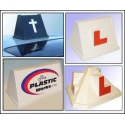Vacuum Forming
Vacuum forming is a thermoforming process, whereby a sheet of plastic is heated to a temperature where it can be formed. The sheet of plastic is then stretched onto a mould with one surface and forced into the mould with a vacuum. In this process, slight angles are necessary to ease the removal of the newly formed plastic past from the mould. Suitable materials for use in vacuum forming are usually thermoplastics, the most common and easiest to use thermoplastic is high impact polystyrene sheeting (HIPS). This plastic sheet can then be moulded around a lot of materials including wood, concrete, structural foam or cast, or machined aluminium mould. The benefits of vacuum forming are that almost any shape can be created. Vacuum forming is a method of thermoforming, which is one of the oldest and most common methods of processing plastic materials in the world. Examples of vacuum formed objects include turnpike signs, protective covers, food packaging, bicycle helmets, and canoes.
-
Talbot Designs Ltd
View company profileOur Teedy™ acrylic stock domes are known for consistent shape and high optical quality and are widely regarded as the best available. Available in almost any size up to 2200mm from as little as 100mm, delivery is normally next day where possible.
Our acrylic domes are used all over the world from pole to pole as we have even supplied these for Arctic and Antarctica observational posts such is the optical clarity. Our acrylic domes can be specified any size to suit the application or utilise our stock ring sizes for speed and cost savings.
Every acrylic dome or dish made is hand checked for shape consistence and optical clarity before despatch using a specially designed check system and due to the sheer quantity made and our material buying power, are generally priced the most competitively available.
-
Perancea Ltd
View company profileWith a wealth of experience, Perancea is able to provide custom and standard enclosures to meet the exacting needs of a broad range of application requirements from mechanical to electrical and electronics engineering solutions. The company is also a highly experienced mechanical engineering organisation, specialising in the production of all types of enclosures including RFI/EMI shielding solutions and plastic and metal fabrication for the electrical, electronics and associated industries.
Perancea: A myriad of electronic packaging solutions
-
Plastic Works Ltd, The
View company profilePLASTIC WORKS LTD covering Derbyshire, Nottinghamshire, Yorkshire, Midlands the UK, Ireland and beyond.
A professional yet friendly company who through extensive technical and process knowledge, strive to provide an unsurpassed service achieving total customer satisfaction.
From the initial design concept, through development & prototyping, our aim is to not only produce a high quality product, but also a cost effective one.Our core areas of business:
Vacuum forming
Thermoforming
Plastic Fabrication
Thermoformed plastic products
Wheel covers
Point of Sale (POS Display Signs)
Paving Moulds
Concrete Moulds
Machine Guards
We believe that through continuous improvement and a close informed working relationship with our customers, we can get you to the market quicker.
We are a contract vacuum former, able to manufacture plastic products up to 8mm thick. Any Grade, Colour And Size (up to 2400mm x 1200mm x 550mm)
Machine Types:- 5 Axis CNC Routing Machine
- Vacuum Forming Machines
- Horizontal Band Saw
- Vertical Band Saw
- Line Bender - 1.5 metres
- Bonding And Assembly
- Granulator- We Believe in Recycling!!!
- Roller Press
-
Brother Moulding Division
View company profileThe Moulding division of Brother Industries (UK) Ltd, (formerly known as GKK Plastics), was formed in 1990 delivering a precision injection moulding and assembly service to a blue chip client base. We are part of the global Brother Group consisting of over 30,000 employees worldwide, with access to the Brother Network and knowledge centres.
Based on a 24,000 sq. metre site in Wrexham, North Wales with good transport links to all areas of the UK. We supply Plastic Mouldings to a diverse range of markets including Electronics, Medical, Agricultural and Construction industries and can provide a total manufacturing service from concept design to finished product.
As specialists in the moulding of technical components, we have extensive assembly experience in both high and low volume manufacturing. Our highly efficient operation and continuous improvement philosophy ensure we remain extremely competitive and can offer the very best value to our customers.
At Brother we will always strive to offer an exceptional service and to meet and exceed our customer’s expectations.
-
ND Precision Products
View company profileND Precision Products are one of the UK’s leading mould and press toolmakers. We are precision toolmakers offering extensive experience in plastic injection mould making, press tools and laser weld tool repairs.
Our established, long retained and highly experienced workforce can offer high priority turnaround times together with a professional and highly competitive precision toolmaking service. ND Precision Products have matched the vast experience built up since its foundation in 1973, with the latest engineering equipment and computer aided design facilities.
-
Interform Manufacturing Ltd
View company profileUsed as a technique for shaping flat plastic into a 3D form, thermoplastic vacuum forming involves heating the plastic sheet until flexible before withdrawing air between the heated sheet and mould.
Thermoplastic vacuum forming is well-suited for medium runs of production and comes with the following benefits:
- Reduced tooling charges
- Significantly reduced machine time and material costs
- Wider material choice
-
The Helping Hand Company
View company profileHelping Hand Manufacturing was established as a separate division of The Helping Hand Company in 2010, located on the well-connected Rotherwas Industrial Estate, Hereford. The main aim of the division is to provide cost effective manufacturing, just in time, with low inventories.
Our production capabilities include Injection Moulding, Vacuum Forming and Metal Fabrication. Manufacturing high quality parts, within an ISO9001:2015 accredited Quality Management System.







